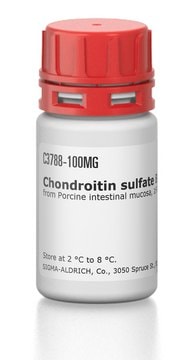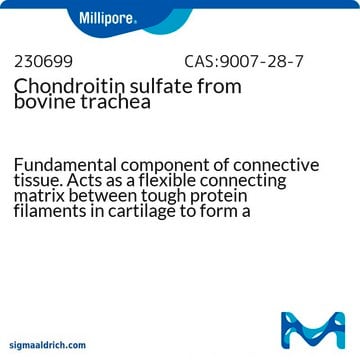C6737
Chondroitin sulfate sodium salt from bovine cartilage
98-102% (CPC, titration)
About This Item
Polecane produkty
pochodzenie biologiczne
bovine cartilage
klasa czystości
standard (for CPC (cetylpyridinium chloride) titration)
Próba
98-102% (CPC, titration)
Postać
powder
aktywność optyczna
[α]20/D -30 to -20 °, c = 5% (w/v) in water
zanieczyszczenia
<10.0% water (Karl Fischer)
kolor
white to off-white
rozpuszczalność
H2O: soluble 50 mg/mL, clear to hazy, colorless to faintly yellow
ślady kationów
Na: 7.4-8.8% (anhydrous)
temp. przechowywania
2-8°C
ciąg SMILES
[Na+].CC(=O)N[C@H]1[C@H](O)O[C@H](CO)[C@H](OS([O-])(=O)=O)[C@@H]1O[C@H]2O[C@@H]([C@H](O)[C@@H](O)[C@@H]2O)C(O)=O
Powiązane kategorie
Opis ogólny
Zastosowanie
Działania biochem./fizjol.
Komponenty
Przestroga
Uwaga dotycząca przygotowania
Inne uwagi
Kod klasy składowania
13 - Non Combustible Solids
Klasa zagrożenia wodnego (WGK)
WGK 2
Temperatura zapłonu (°F)
Not applicable
Temperatura zapłonu (°C)
Not applicable
Środki ochrony indywidualnej
Eyeshields, Gloves, type N95 (US)
Certyfikaty analizy (CoA)
Poszukaj Certyfikaty analizy (CoA), wpisując numer partii/serii produktów. Numery serii i partii można znaleźć na etykiecie produktu po słowach „seria” lub „partia”.
Masz już ten produkt?
Dokumenty związane z niedawno zakupionymi produktami zostały zamieszczone w Bibliotece dokumentów.
Klienci oglądali również te produkty
Nasz zespół naukowców ma doświadczenie we wszystkich obszarach badań, w tym w naukach przyrodniczych, materiałoznawstwie, syntezie chemicznej, chromatografii, analityce i wielu innych dziedzinach.
Skontaktuj się z zespołem ds. pomocy technicznej







